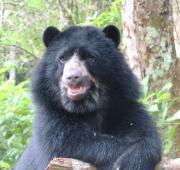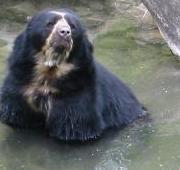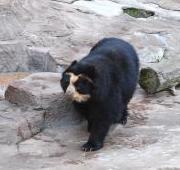 The spectacled bear is also known as the Andean bear, mainly because the spectacled bear is native to the Andes mountain range of South America. The spectacled bears territory ranges from northwest Argentina, into Peru, Venezuela and Brazil.
The spectacled bear is also known as the Andean bear, mainly because the spectacled bear is native to the Andes mountain range of South America. The spectacled bears territory ranges from northwest Argentina, into Peru, Venezuela and Brazil. The spectacled bear generally feeds on berries and shoots found both on ground level and in the trees. The spectacled bear also feeds on insects and small mammals and reptiles, and occasionally cattle.
The spectacled bear generally feeds on berries and shoots found both on ground level and in the trees. The spectacled bear also feeds on insects and small mammals and reptiles, and occasionally cattle.


The spectacled bear is thought to be non-territorial but the spectacled bear appears to distance itself naturally from other large animals particularly humans. It is because of this that the spectacled bear is not thought to be aggressive when it encounters people and the spectacled bear is therefore reported to be docile yet curious when seeing human beings.
Like many other species of bear, the spectacled bear mothers have been said to attack people when they believe that their spectacled bear cubs are in danger. Although the spectacled bear is a medium sized bear with the average adult spectacled bear growing to around 1.5 meters tall, an aggravated spectacled bear mother will use all of her bear power and skills to protect her young family.
The spectacled bear population is thought to be severely under threat and has been decreasing rapidly over recent years. This is because local farmers believe that the spectacled bear kills livestock, the natural habitat of the spectacled bear is ever decreasing, and the gall bladder of the spectacled bear is believed to have medicinal properties in Oriental medicine so the spectacled bear is always under threat from International poaches as well as native poachers.

